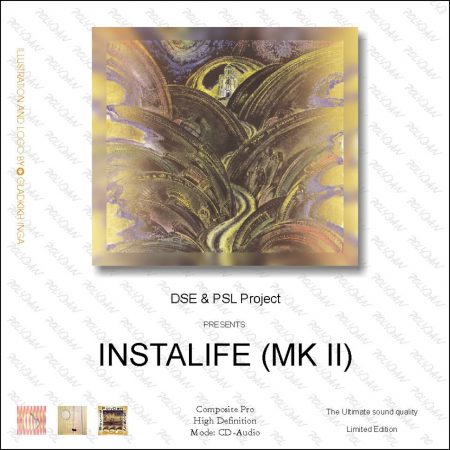production and pre-production areas
(demonstration sample not for sale to the general public)
— The Ultimate sound quality
— Limited Edition
— Composite Pro
— High Definition
— Mode: CD-Audio
Zone No. 1
(tr. 1 — 13)
Pre-press sound refers to the original master recording (pre-master) that retains the
highest signal accuracy without alterations caused by mass production processes. It preserves the full dynamic range, temporal precision (minimal jitter), and the original harmonic structure
Tracks 1, 2, 3 — Phase alignment check in speakers. If all connections are correctly made within the equipment, speaker crossovers, interconnects, and speaker cables, the announcer’s voice should be positioned strictly between the speakers at all three test frequencies.
If connections are incorrect, the voice will be heard to the left and right of the speakers.
Track 4 — Artificial recording of a tambourine moving in a circular path around two microphones.
Used for initial speaker placement. The sound should move evenly in a circle around the listener.
Track 5 — Natural recording of a tambourine moving in a circular path around two microphones.
Used for final speaker placement. The sound should move evenly in a circle, without appearing to “jump,” linger in one place, change volume abruptly, or simply move left and right.
DO NOT “TOE-IN” THE SPEAKERS TOWARD THE LISTENER
Track 6 — Checking the “coherence” of a piano’s sound.
If the speakers are placed too far apart, the sound in the middle between them may seem
absent (disconnected). However, the speakers should be spaced as widely as possible
Track 7 — Depth of soundstage check.
The first tambourine strikes were recorded between the microphones. The following strikes were recorded progressively farther from the microphones, into the depth of the soundstage. As the tambourine moves deeper into the soundstage, the spatial characteristics of the recording environment should become increasingly prominent
Track 8 (Main test track) — The sound of galloping horses begins in the front left corner of the room,
moves through the listening position, and ends in the rear right corner of the room.
The movement should be smooth, without jumps or delays
Track 9 — This track contains both bright effects and subtle sounds, with a sharply defined triangle sound
Track 10 — This track should reveal the emotional expression of a young performer, as well as the distinct tonal character of the piano
Track 11 — This track clearly illustrates the spatial volume of a train station environment
Track 12 — A gradual transition can be distinctly heard, from voices and footsteps in an open
space to voices and footsteps in a closed space (a cave).
Track 13 — Artificial wind sound (a circular sound field created with a joystick) (0:39 min.)
Zone # 2
(tr. 14 — 22)
Pre-press sound refers to the original master recording (pre-master) that retains the highest signal accuracy without alterations caused by mass production processes. It preserves the full dynamic range, temporal precision (minimal jitter), and the original harmonic structure
Track 14 — Artificial recording of a tambourine moving in a circular path around two microphones.
Used for initial speaker placement. The sound should move evenly in a circle around the listener
Track 15 — Natural recording of a tambourine moving in a circular path around two microphones.
Used for final speaker placement. The sound should move evenly in a circle, without appearing to “jump”
linger in one place, change volume abruptly, or simply move left and right
Track 16 — Checking the “coherence” of a piano’s sound.
If the speakers are placed too far apart, the sound in the middle between them may seem absent.
However, the speakers should be spaced as widely as possible.
Track 17 (Main test track) — The sound of galloping horses begins in the front left corner of the room,
moves through the listening position, and ends in the rear right corner of the room.
The movement should be smooth, without jumps or delays.
Track 18 — This track contains both bright effects and subtle sounds, with a sharply defined triangle sound.
Track 19 — This is the most “difficult” track, as it should convey the emotional expression of a young performer,
as well as the distinct tonal character of the piano.
Track 20 — This track clearly illustrates the spatial volume of a train station environment.
Track 21 — A gradual transition can be distinctly heard, from voices and footsteps in an open space
to voices and footsteps in a closed space (a cave).
Track 22 — Artificial wind sound (a circular sound field created with a joystick)
Tracks 23-27 — Additional tracks — demagnetization of system components
3:05 min. of cacophony should be played at a medium or higher volume level
Total Time Playing: 56:36 min.
TRUST YOUR EARS BUT NOT GENERAL IDEAS!









